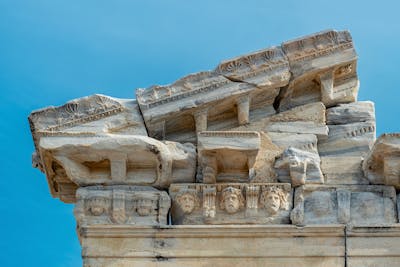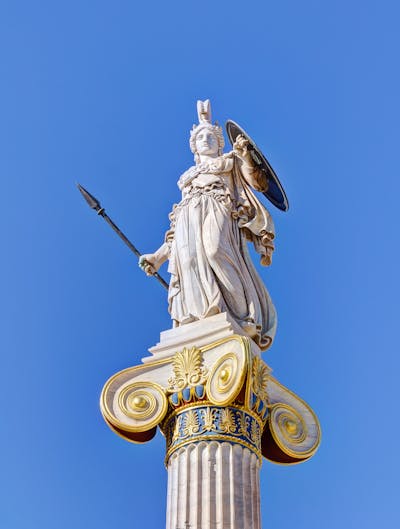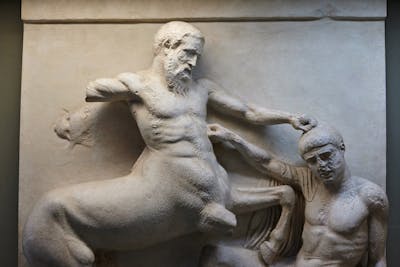Athens, a city steeped in history and culture, stands as one of the oldest continuously inhabited cities in the world, with its origins tracing back over 3,400 years. Known as the cradle of Western civilization and as the capital of Greece, it continues to captivate the imagination of the world.
At the heart of Athens lies the Acropolis, a site revered as a symbol of ancient Greek glory. Among its architectural marvels, the Parthenon stands out as a crowning achievement. This temple, dedicated to the goddess Athena, is not only an enduring icon of ancient Greek civilization but also a masterpiece of classical architecture. Each year, the Acropolis and the Parthenon attract throngs of visitors, drawn to their timeless beauty and historical significance.
Parthenon Athens - In a Nutshell
Parthenon Athens Timings
8am-8pm from 1st April-31st October
8am-5pm from 1st November-31st March
Know before you go
Best time to visit: October and November
Starting Prices for Parthenon Athens Tickets at €22.
Suggested duration: 3 hours
Location: Athens
Address
Athens 105 58, Greece
Get there
The Parthenon in Athens

The city of Parthenon is an open-air museum and the pièce de résistance of the Parthenon is the Parthenon Temple. The Parthenon Temple dominates the hills of the Acropolis. Built in the mid-fifth century, the Temple is dedicated to the Greek Goddess Athena Parthenos or ‘Athena the Virgin'.
Originally built as a grand rectangular white marble temple, the Parthenon has been the victim of many vicious battles. These battles wreaked havoc on the Parthenon and caused irreparable damage to most of the sculptures of the Parthenon. But, despite this, the basic structure of the Parthenon has remained intact. The Parthenon in Athens is a simple and austere column constructed in the Doric order - the simplest of the three classical Greek architectural orders.
The Parthenon is one of the most well-known landmarks of Athens and it can be seen from all the corners of the city of Athens. The Parthenon in Athens is the most important surviving building of Classical Greece. Since its inception, the Parthenon of Athens has been used as a Christian Church and even as an Islamic mosque.
Parthenon V/s Acropolis
.jpg)
The Acropolis is the most important symbol of Western civilization. It is the greatest sanctuary of Athens and was constructed in honor of the Greek Goddess Athena-daughter of Zeus. Athena is believed to be the Protector of Athens and the Greek Goddess of courage, wisdom, inspiration, law, justice, strategic warfare, and mathematics. Simply put, both the Acropolis and the Parthenon are glorious odes to Athena.
The Acropolis is one of the greatest achievements of European culture and the most important monument in Greece. Classified as a UNESCO World Heritage Site in 1987, the Acropolis is home to many historical monuments. All the monuments on the Acropolis have inspired the current ideas about democracy and human rights.
The Parthenon Temple, dedicated to Athena, is found in Acropolis. The rectangular white marble structure of the Parthenon Temple dominates the hills of the Acropolis in Athens. The Parthenon of Athens can also be seen from all the corners of Athens. Believed to be the most important surviving building from the Classical Greek era, the Parthenon Temple has functioned as a Christian Church and even as an Islamic Mosque. Currently, the Parthenon is undergoing some major renovation work.
Which Parthenon tickets should you choose?
To visit the Parthenon in Athens, you can choose many types of tickets - one that gives guided tour, with early access to the Acropolis or the Athens pass ticket that gives you access to the Acropolis along with six other attractions.
Purchase your preferred ticket online with Headout, since we can help you save you time on the day of your visit. The tickets will allow you to skip-the-line and get priority entry into the Acropolis and other attractions.
Why should you visit the Parthenon?

The Parthenon Athens is considered to be the greatest surviving monument of Classical Greece. Dedicated to Athena Parthenos or ‘Athena the Virgin,’ the Parthenon Temple in Athens is a sight to behold as its rectangular white marble glistens and looms over the hills of Acropolis, Athens.
Built in the mid-fifth century, the Parthenon in Athens has played different roles throughout the years. It has functioned as a treasury, a Christian Church, and even an Islamic Mosque. The Parthenon in Athens is a rectangular white marble structure that stands as a simple and austere column covered with a capital, which is characteristic of the Doric order - the simplest of the three Classical Greek architectural orders. Though most of the structure of the Parthenon in Athens was damaged, including most of its sculptures, the basic structure of the Temple remains intact. However, the Parthenon Temple is currently undergoing some major renovation works, so most of the Parthenon in Athens is covered with scaffoldings.
Plan your visit
Best time to visit the Parthenon
- The least crowded time to visit the Parthenon of Athens is during the opening time i.e., 8 am or at the end of the day, one or two hours before the closing time.
- Avoid visiting the Parthenon of Athens between 10am and the early afternoon.
- Around 10am, cruise ship crowds visit the Parthenon Athens making it very crowded. Try not to visit the Parthenon during the summers, especially at midday since it is swelteringly hot and extremely crowded.
- It is not a good idea to visit the Parthenon in Athens during the rainy season as well, since the area becomes extremely slippery and dangerous to walk on during this season.
Parthenon Timings
- During the summers or from 1st April to 31st October, the Parthenon in Athens is open from 8 am - 8 pm. During the winter or from 1st November to 31st March, the Parthenon of Athens is open from 8 am - 5 pm.
- The Parthenon of Athen is closed on 1st January, 25th March, 1st May, Easter Sunday, 25th December, and 26th December.
- Visitors can enter the Parthenon in Athens free of cost on the first Sunday of every month.
- Free admission is also allowed on 6th March, 18th April, 18th May, the last weekend of September, and 28th October.
Practical Information


- If you are traveling by Metro, the closest station to the Parthenon of Athens is Acropoli, which is a 2-minutes walk away from the southeast entrance to the Parthenon Athens.
- If you are coming from the Airport, hop onto the blue line, get off at Syntagma station and transfer to the red line in the Elliniko direction, and exit at Acropoli.
- You can also take the blue line #M3 to Monastiraki, which is a 12-minutes walk away from the Parthenon in Athens.
- The green line to Thissio, which is a 14 minutes walk away from the Parthenon Athens, is another option that you can choose.
.jpg)
- If you are traveling by bus, the closest bus station to the Parthenon in Athens is Akropolē which is an eight-minute walk away from the Acropolis of Athens.
- The Makriyianni bus stop is a ten-minute walk away from the Acropolis of Athens. Bus routes 24, 40, 126, 134, A2, A3, A4, and 57 all ply on this route.
- You can also take bus 035 to the Monastiraki stop which is a 10-minutes walk away from the Parthenon in Athens.
- If you are coming from the airport, take bus X95 to the Syntagma station which is 1.5 kilometers away from the Acropolis.

- You can either rent a car or take a cab to the Acropolis in Athens. It takes 30 minutes from the airport to reach Acropolis.
- You can park your car, free of charge, on the street in the Koukaki area.
- Paid parking is available at three places-Metropark Athens, Parking Kostas, and Parking Siggrou 32.
- The Metropark Athens is within walking distance of the Parthenon in Athens and is open on all days of the week.
- The Parking Kostas is situated at Aggelou Vlachou 8 which is a 10-minutes walk from the Acropolis.
- The Parking Siggrou 32 is an outdoor parking space that is open till 10pm every day.


- There is no specific dress code for visitors visiting the Parthenon in Athens. However, we recommend that you wear comfortable clothes and comfortable footwear when visiting the Parthenon.
- Avoid wearing high heels as the stones and pathways of the Parthenon and Acropolis are uneven and slippery, especially during the rainy season.
- Furthermore, there are signs around the area that clearly mention that high heels are prohibited.



- The Acropolis is wheelchair accessible. Disabled visitors and an escort are allowed free entry into the Parthenon of Athens.
- In 2021, the Greek government launched a massive initiative to make the Acropolis and Parthenon easily accessible for everyone. This includes the construction of flat, concrete paths throughout the Acropolis and Parthenon in Athens.

- An on-site elevator is available at the Acropolis which takes disabled visitors up to the Parthenon.
- There are times when the elevator may not be functioning. To avoid this, call on +30 210 3214172 before planning a visit with a person with health conditions or impairments to check whether the elevator is functioning or not.

- Water fountains and public bathrooms are available at the Acropolis.
- Just to be on the safe side, carry your own water bottles, tissues, and hand sanitizer.
History behind the Parthenon in Athens
Like all remarkable structures, the Parthenon of Athens is steeped in rich history, mythology, and even magic. The Parthenon of Athens was part of a massive rebuilding program headed by Pericles. Pericles envisioned a site exclusively dedicated to the Goddess Athena. The main entrance of the Parthenon-Propylaea was the gateway. The Erechtheum was a shrine dedicated to agricultural deities, especially Erichthonius. The Temple of Athena Nike was symbolic of the harmony with which the Ionians and Dorians lived under the Athenian government, and the Parthenon was the crowning glory of this site. Acclaimed sculptor Phidias, even installed an ivory-and-gold statue of Athena inside the Parthenon Athens.

Renowned architects Ictinus and Callicrates started the construction of the Parthenon, under the supervision of Phidias, in 447 BCE. The Parthenon was completed in 438 BCE and the ivory-and-gold sculpture of Athena was installed in the interior of the Temple in the same year. However, work on the exterior of the Parthenon of Athens continued till 432 BCE. It took almost fifteen years to construct this iconic Greek monument!
In 1687, the center of the building was destroyed due to bombardment by the Venetians. In 1801, Thomas Bruce removed some of the remaining sculptures from the Parthenon. After gaining Independence, a forty-year restoration of the Parthenon in Athens was undertaken.
Parthenon history - A timeline
447 BCE: Under the supervision of Phidias, architects Ictinus and Callicrates started the construction of the Parthenon of Athens.
438 BCE:The interior of the Parthenon in Athens is completed and Phidias’ structure of the Greek Goddess Athena is installed inside the Parthenon.
432 BCE: Exterior work on the Parthenon is completed.
7th Century: The Athena statue is removed from the Parthenon as it becomes the Byzantine Church.
1458-1460: The Turks seized the Acropolis and converted it into an Islamic mosque. The only alteration to the original structure was the raising of a minaret in its southwest corner.
1684-1699: During the Morean Wars, the center of the Parthenon was destroyed due to bombardment by the Venetians in 1687.
1821-1829: Greece gained Independence from the Ottoman empire. Europeans undertook a repainting program of the Parthenon of Athens.
1975: A multi-decade restoration of the Parthenon is undertaken post-Greek Independence.
2021-Now: The Parthenon is currently undergoing major renovation works.
Parthenon - Architecture and design
The iconic Parthenon of Athens is one of the finest examples of Greek architecture. Built in classical architectural style, the Parthenon of Athens can be seen from all the corners of the city of Athens. Famous architects Ictinus and Callicrates started their work on the Parthenon under the supervision of Phidias-the sculptor known for creating the ivory-and-gold statue of the Greek Goddess Athena. The Parthenon of Athens was created for two purposes - to serve as the Chief shrine for Athena and to function as Treasury for the Delian League-a confederacy of the states of Ancient Greece under the leadership of Athens.
Created in the Doric Order-the simplest of the three Classical Greek architectural orders, the Parthenon has a base of 228 feet by 101 feet. The Parthenon of Athens has all the characteristic elements of the Doric architectural order.

The frieze is a broad, horizontal band of sculpted or painted decorations. In the case of the Parthenon of Athens, a continuous low-relief frieze ran around the top of the exterior wall of the ‘cella’ or the inner chamber. The frieze of the Parthenon depicts the Panathenaic procession of citizens honoring Athena.

The pediment is the triangular upper part of a classical building. The Parthenon in Athens consists of two pediments - an east pediment and a west pediment.
East Pediment: Depicts three witnesses, believed to be goddesses who witnessed the birth of Athena.
West Pediment: This shows the mythical battle fought between Athena and the Sea God Poseidon for becoming the God of the city of Athens.

In 438 BCE, after the interiors of the Parthenon were completed, Phidias installed his famed Athena Parthenos sculpture in the Parthenon of Athens. The gigantic statue was a staggering 11.5 meters tall. The majestic statue depicted Athena standing fully armed in all her glory. In her right hand, the Goddess was shown to be holding a statue of Nike-the Greek god of victory, and in her left hand, she held a large circular shield.

Metopes are plain blocks with relief structures. All four - east, south, west, and north metopes of the Parthenon of Athens are carved in high relief and showcase mythical Greek battles.
Types of Metopes: East, South, West and North
Map of Parthenon Athens
Parthenon facts that you probably didn’t know
- The Parthenon has functioned as a Treasury, a Christian Church, and an Islamic Mosque since its construction in the mid-fifth century.
- Thomas Bruce, a Scottish nobleman, transported half of the remaining sculptures of the Parthenon by sea to Britain. These sculptures can be found in the British Museum.
- The Parthenon of Athens borrows its name from ‘parthenoi.’ This refers to the maidens who participated in the sacrifices to the Goddess Athena.
- The war between the Ottoman Empire and the Holy League led to the bombing of the Parthenon. This caused irreparable damage to the Parthenon of Athens and its sculptures.
- A meticulously detailed replica of the Parthenon can be seen in the Centennial Park located in Nashville, Tennessee.
Insider tips
- The Parthenon Athens has two entrances - the main entrance Propylaea and a side entrance. Use the side entrance to enter the site.
- Read up on the Acropolis and Parthenon in advance, so the trip will be more fun and interesting.
- Purchase your tickets online and opt for a guided tour to save time.
- The best time to visit the Parthenon in Athens is during its opening time and/or one or two hours before the closing time.
- Avoid visiting the Parthenon from 10am to early afternoon.
- The stones and pathways of the Parthenon and Acropolis are uneven and slippery at times. Make sure that you wear comfortable footwear when visiting the Parthenon in Athens - Do not make the mistake of wearing high heels!.
- Have a snack before entering the Parthenon, since it would typically take hours before you get out.
- If visiting the Parthenon during summers, carry a hat, a pair of sunglasses, a water bottle and sunscreen.
Places to visit around Parthenon Athens
Hotels near Parthenon Athens
Here are the top four places to stay nearby if you're planning to visit the Parthenon

The AthensWas hotel is a five-star property located on Dionysiou Areopagitou 5. The rooms of this boutique hotel have been made in a sleek, modern, and contemporary style. Enjoy the beautiful view of the Acropolis and Parthenon from your very own private balcony, or when you are enjoying a delicious meal at the AthensWas Hotel’s rooftop restaurant.

Located in the heart of Athens, the Acropolis View Hotel is one of the most well-located hotels in the city of Athens. The Acropolis View Hotel is located at 10 Webster Street. The main attractions of Athens, such as the Acropolis, Old Plaka Temple, and the Temple of Olympian Zeus are just a short walk away from this charming hotel.

Located on 48 Syngrou Avenue, the centrally located hotel is a three-star property that is close to all the local attractions. The hotel provides airport transfers to and from the hotel and offers free WiFi in all its rooms. The hotel even boasts of an on-site spa and a laundry service. After a tiring day spent visiting the Acropolis and its surrounding monuments, be sure to book yourself a relaxing spa session at the Acropolis Museum Boutique Hotel!

The Athens Gate Hotel is located at 10 Syngrou Avenue. The hotel is close to all local attractions and only 180 meters away from public transportation. Pets are allowed inside the hotel, and the hotel even has its own parking space. Free Wifi is provided in all the rooms. The hotel also serves an excellent breakfast, so make sure to fill yourself up with a hearty breakfast before you go off to explore the Acropolis and the Parthenon!
FAQs
The best time to visit Parthenon Athens is from October to November.
Plan on spending at least half a day if you want to see all of the main sights. If you're only interested in visiting the Parthenon itself, an hour or two should be sufficient.
The most popular things to do at Parthenon Athens include exploring the Acropolis, visiting the Temple of Olympian Zeus, and admiring the views from the Lycabettus Hill, the highest point in Athens.
Yes, children don’t need tickets. All children under 5 years of age and European citizens under 25 are assured of a free entry, provided they have ID proof.
Some tips for visiting Parthenon Athens include wearing comfortable shoes, bringing plenty of water, and being prepared for crowds. Also, be sure to check the opening hours of the sights you want to visit in advance.
Yes, we offer several tours of Parthenon Athens, with experienced tour guides. However, you can also explore the Acropolis on your own if you've got enough time. Pick up a map at the entrance and take your time walking around.
Yes, There is an elevator to carry passengers between the floors in the Parthenon, and there are also wheelchair-accessible toilets in the area.
Other top experiences in Athens
The historic city of Athens has tons of other attractions you can visit after your trip to the Parthenon. Here are some other attractions that are now open to the public that cannot be missed! Check out more things to do in Athens.


.jpg ?fm=pjpg&auto=compress&w=125&h=125&crop=faces&fit=min)








